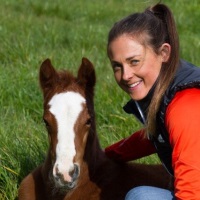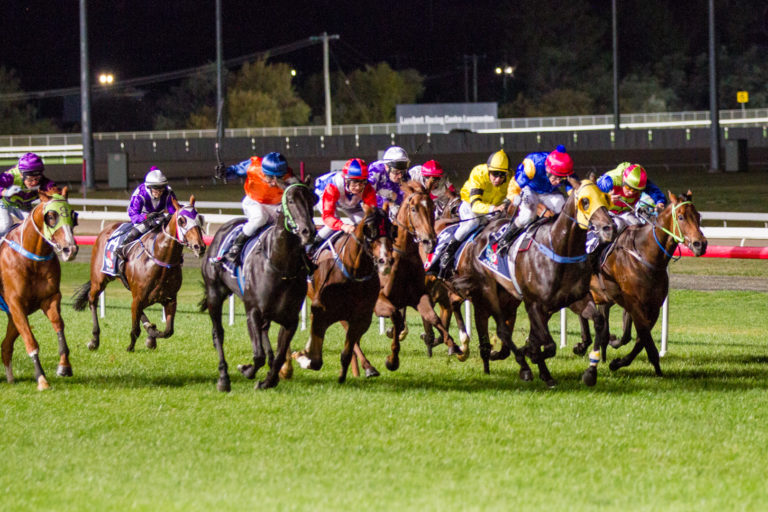Tying up is a broad term used to classify a wide variety of muscle disorders which result in the dissolution of muscle cells during exercise. Technically known as ‘exertional rhabdomylosis’ (ER), this syndrome is the most common muscle disorder which affects exercising horses.
Clinical signs of ER vary, depending on the severity of the condition. Symptoms of tying up can occur during exercise, and are most commonly exhibited within two hours of completing exercise. The classic picture of a horse effected by ER is that of one with an increasingly short, stiffened stride during exercise, then being very reluctant or unable to move after exercise. Many adopt an unusual stance, looking as though they wish to urinate. The muscles of the hindquarters are usually the most severely effected: being firm, painful and cramping. Other signs such as profuse sweating and elevated heart, temperature and respiratory rate are commonly part of the ER picture. Many horses will paw the ground with their front legs. In severe cases, horses will pass a red-brown coloured urine (known as myoglobinuria). This occurs due to the extensive damage of muscle fibres leaking myoglobin (a muscle protein) into the blood, which is then subsequently excreted through the kidneys.
Classification
Based on current understanding of tying up, horses can be classified into two different types:
- Sporadic ER: these horses experience generalised signs of tying up on rare occasion;
- Chronic ER: these horses experience repeated episodes of tying up, with the first occurrence usually at a young age.
Some research suggests that a third type exists: Subclinical tying up. These horses do not exhibit severe clinical signs, but may have an associated loss of performance, poor finishing ability (in races), pain over the effected muscle(s) and subtle gait abnormalities.
Recent research differentiates between two distinct types of Chronic ER: Recurrent Exertional Rhabdomylosis (RER) in which there is a defect in the mechanism of muscle contraction; and Polysaccharide Storage Myopathy (PSSM), a disorder which results in excessive carbohydrate storage in muscles.
Diagnosis
Diagnosis of ER and RER is based on a history, or current clinical signs of stiffness and muscle pain after exercise, combined with confirmation by elevated blood enzyme levels of creatine kinase (CK) and aspartate aminotransferase (AST).
Contributing and risk factors
Current understanding of tying up suggests that there are multiple potential causes and contributing factors associated with ER. Those which result in a case of tying up will vary between individual horses, and most horses who experience ER will be sensitive to a combination of different factors. These include:
- Exercising beyond current fitness level
- Hormonal influences
- Electrolyte imbalances
- Various vitamin and mineral deficiencies/insufficiencies
- Long periods of travel
- Rest days
- Fillies: Fillies have four times the risk compared to geldings
- Age: the incidence of ER generally decreases as a horse ages
- Nervous disposition
- Genetic predisposition
- High grain/high starch diet
- Altered carbohydrate metabolism
- Hypotension (low blood pressure)
- Hypothyroidism
- Dehydration
- Viral infection
- Medication use (for example corticosteroids)
Prevention and Management Strategies
As with any health condition in a horse, a holistic approach which covers nutritional, exercise, management and supplementation practices is the most effective approach to preventing and managing ER episodes.
Exercise
Ensuring a horse is properly fit for the competition/exercise it is about to undertake is one of the first considerations in relation to tying up, particularly sporadic ER. Although self explanatory, it is amazing how often horses are taken to competitions with minimal riding and conditioning prior to the event.
Horses which have suffered a prior episode of tying up are best exercised on a daily basis, following a consistent, structured program. Complete rest days are best avoided. This does not have to mean they are ridden daily: hand-walking and longeing are also suitable.
Ensure that a thorough warm-up and cool down are completed before and after ridden work at home and competitions- this helps stimulate oxygen delivery to prepare the muscles for exercise, and reducing lactic acid levels in muscle tissue.
Management
The incidence of tying up episodes can be reduced by effective management practices. Keeping a horse turned out in a paddock (as opposed to stabled) is preferable, as this encourages natural, incidental movement. Avoiding situations and environments which unnecessarily stir-up a horse is also important. Horses which become unduly anxious or excited experience fluctuations in cortisol levels, which further disrupt other hormone levels in the body, increasing the risk of tying up.
Travel
Many competitions are associated with travelling long distances to and from the event, thus providing important opportunities to adopt practices which may help prevent tying up. Ensure horses are properly hydrated before and after travel, and offered electrolytes when travelling long journeys and/or in hot weather. At a minimum, horses should have free access to a pure salt lick (such as a Himalayan salt block). When arriving at the competition, it is advisable to handwalk the horse for a minimum of 15-20 minutes upon unloading (also remember to do this upon arrival back home after the competition!). When travel involves overnight stays away from home, turnout in a
medium sized yard (as opposed to a small yard or stable), which the horse can freely walk around in is most preferable. It is important to ensure that at completion of competition, horses are cooled down properly before being loaded to travel home.
Diet
In many cases, easily implemented dietary changes can have a most profound impact on horses susceptible to tying up. One of the first steps is to significantly reduce grain intake, substituting with fat sources to meet the horse’s energy requirements. Ensure that the horse is also receiving a minimum of 1.5% of its body weight in forage daily, this is important for the provision of energy, stabilising blood glucose and in turn hormonal levels and optimising health of the gastrointestinal tract.
The inclusion of free access to salt in the diet is important, as most feeds are generally very low in sodium chloride.
Nutritional Supplementation
Despite the wide availability and use of fortified feeds, the judicial use of specifically indicated nutritional supplements is most beneficial for horses susceptible to ER. Electrolytes (potassium, sodium and chloride), magnesium, calcium, vitamin B1, vitamin C, vitamin E, selenium, chromium and selected amino acids may all help to prevent tying up. Each of these nutrients plays specific roles in the body. When supplementing a horse, it is essential to seek professional advice, both for your horse’s safety and in the best financial interests of you as the owner! No horse should ever be on a cocktail of supplements: each therapeutic given to the horse should have a clear role and timeline for its indicated use. It is of vital importance to know that specific nutrients can be toxic in high doses; the bioavailability (how much of the supplement a horse can absorb and use) varies dramatically between supplement brands and forms; and some nutrients compete for absorption, therefore decreasing the amount available for the horse’s body to use.
Herbal Therapy
Herbal medicine offers a valuable toolbox of therapeutic options for the horse susceptible to tying up. Suitable herbs can effectively aid in naturally regulating hormonal levels; relaxing muscles; promoting increased blood flow to muscles and removal of lactic acid and metabolic by-products from the muscles; balancing electrolyte levels; and supporting immune function.
As with nutritional supplementation, it is important to seek the guidance of a fully qualified professional when using herbal therapies. For both safety and efficacy, the selection of appropriate herbs, using pure unadulterated extracts, in suitable doses for each horse is essential. Furthermore, some herbs have restricted use in competition and are swabbable.
Conclusion
Despite being the most common muscle disorder of exercising horses, ER is a condition which the occurrence of can be reduced by effectively implementing a holistic approach. Adopting appropriate exercise, management, dietary and supplementation regimes are vital factors in the horse at risk of tying up.

Camilla Whishaw is a highly regarded, experienced horsewoman and naturopath, helping to holistically treat and manage a broad range of equine health conditions and injuries, with a passion for mare and stallion fertility.
As a world-renowned practitioner, presenter, author, and consultant in the field of Equine Naturopathy, Camilla shares her knowledge through keynote presentations, interviews, lectures, panel sessions, and workshop training.





